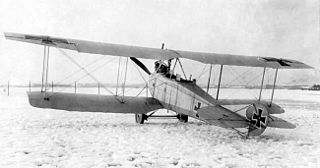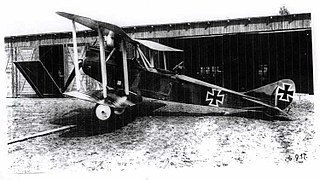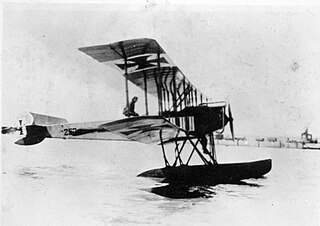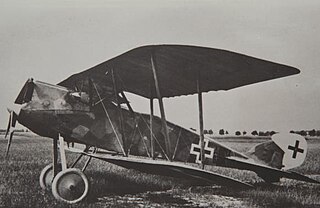| C.VIII | |
|---|---|
 | |
| An oblique view of the Aviatik C.VIII | |
| Role | Reconnaissance aircraft |
| Manufacturer | Aviatik |
| First flight | 1917 |
| Number built | 1 |
The Aviatik C.VIII was a prototype German observation aircraft built by Aviatik in World War I.
| C.VIII | |
|---|---|
 | |
| An oblique view of the Aviatik C.VIII | |
| Role | Reconnaissance aircraft |
| Manufacturer | Aviatik |
| First flight | 1917 |
| Number built | 1 |
The Aviatik C.VIII was a prototype German observation aircraft built by Aviatik in World War I.
The C.VIII was a development of the C.VII with the former's BMW IV engine replaced by the simpler Benz Bz.IV. It was an aerodynamically clean biplane with a minimum amount of biplane box struts and a cut-out in the upper wing to improve visibility from the cockpit. Like the Halberstadt CL.II, the Aviatik C.VIII had a plywood-covered fuselage tapering down to a narrow tail. [1]
The Aviatik C.VIII was judged obsolete in 1917 given the deployment of an observer in front of the pilot.
Data from , [2] Aviatik aircraft of WWI : a centennial perspective on great war airplanes [3]
General characteristics
Performance
Armament

The Aviatik C.I was an observation aircraft which came into service during World War I in April 1915. It was a development of the Aviatik B.I and B.II models, being one of first aircraft of the new German C class of armed biplanes. In the C.I the observer sat in front of the pilot, with a machine-gun clipped on a sliding mounting fitted on a rail at either side of the cockpit. It gave the crew the means to attack enemy aircraft. The positions of the pilot and observer were reversed in last series of 50, ordered in 1917 solely for trainer purpose. There was only one aircraft built of refined C.Ia version in May 1916, with armament still in a forward cab, serving as a prototype for C.III. Later models of the plane included the Aviatik C.II and the C.III, which had more powerful engines. The C.III was produced in large numbers.

The Aviatik B.I is a German two-seat reconnaissance biplane designed and built by the Automobil und Aviatik AG company, who until then had produced copies of French designs.

The Friedrichshafen G.I was a prototype heavy bomber aircraft that was built in Germany by Flugzeugbau Friedrichshafen in 1915. It was Karl Gehlen's first design for the company, and although it was not produced in quantity, it provided the foundation for the later, highly successful bombers culminating in the G.III.

The Friedrichshafen FF.31 was a two-seat prototype German maritime reconnaissance floatplane built by Flugzeugbau Friedrichshafen during the First World War. Although primarily intended for reconnaissance duties, the aircraft was provided with a machine gun to engage other aircraft. Although it was satisfactory for its intended mission, it lacked the performance necessary for use as a fighter. A pair of aircraft were built in 1915 and it was not accepted for production by the Imperial German Navy's Naval Air Service.

The Rumpler C.IV was a German single-engine, two-seat reconnaissance biplane. It was a development of C.III with different tail surfaces and using a Mercedes D.IVa engine in place of the C.III's Benz Bz.IV. The Rumpler 6B 2 was a single-seat floatplane fighter variant with a 120 kW (160 hp) Mercedes D.III engine built for the Kaiserliche Marine.

Entering service in 1915, the Rumpler C.I,, two-seater single-engine reconnaissance biplane, was one of the first German C-type aircraft, and also one of the longest serving in its class during World War I, being retired from the last front line units only in early 1918.

The DFW C.IV, DFW C.V, DFW C.VI, and DFW F37 were a family of German reconnaissance aircraft first used in 1916 in World War I. They were conventionally configured biplanes with unequal-span unstaggered wings and seating for the pilot and observer in tandem, open cockpits. Like the DFW C.II before them, these aircraft seated the gunner to the rear and armed him with a machine gun on a ring mount. Compared to preceding B- and C-class designs by DFW, however, the aerodynamics of the fuselage were more refined, and when coupled with more powerful engines, resulted in a machine with excellent performance.

The Gotha WD.2 and its derivatives were a family of military reconnaissance aircraft produced in Germany just before and during the early part of World War I.

The Gotha WD.14, WD.20, and WD.22 were a family of biplane torpedo bomber floatplanes developed in Germany during World War I.

The Rumpler B.I was a military reconnaissance aircraft produced in Germany during World War I.

The Rumpler G.I was a bomber aircraft produced in Germany during World War I, together with refined versions known as the G.II and G.III.

The Friedrichshafen FF.71 was a German biplane floatplane produced by Flugzeugbau Friedrichshafen.

The Aviatik D.VII was a prototype German single-seat biplane fighter aircraft built by Aviatik in the last year of the First World War. It could not participate in the Third Fighter Competition of October 1918 because it used the wrong engine and it saw no military service, although 50 aircraft were found in storage after the war. The only real major change from the earlier Aviatik D.VI was a completely new tail structure.

The Zeppelin-Lindau CS.I was a German single-engined reconnaissance seaplane with a low-wing monoplane layout.

The Aviatik C.IX was a prototype German observation aircraft built by Aviatik in the final months of World War I.

The Aviatik D.VI was a German prototype single-seater fighter aircraft of the First World War, designed by Aviatik.
The LVG C.VIII was a prototype reconnaissance aircraft built in Germany during World War I.
The LVG D.IV was a German fighter plane built by LVG in World War I.

The LVG D.VI was a prototype German biplane fighter built by LVG in World War I.
The Märkische D.I was a prototype single-seat fighter biplane built in the last months of World War I.
{{cite book}}: |first1= has generic name (help)